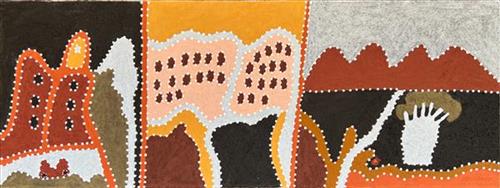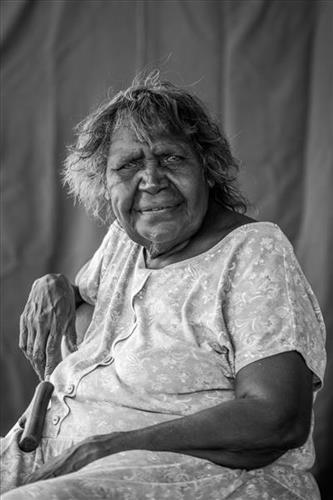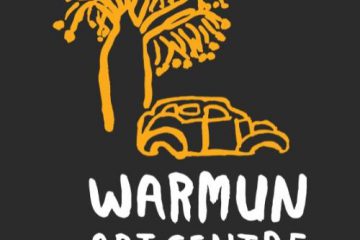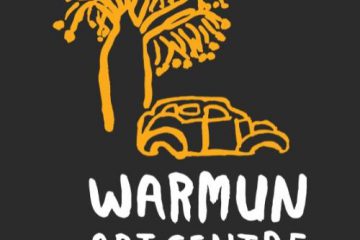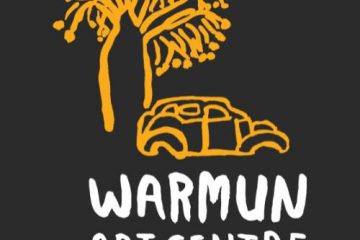110682253198
Goordbelayinji (all massacre places)
This triptych by Shirley Purdie recalls 3 massacres that have occurred on Gija country. As described by the artist each massacre is inspired by very different motives. These different events, placed side by side, are seemingly unrelated, however each is significant to Shirley as they shape the experience of her country and mark the enormous changes that have been witnessed, and remain in the living memory.
Gilbany (Mabel Downs)
(far left)
‘This lot really old people. They never seen gardia (white man) before. They bin look from that big hill at Gilban (Mabel Downs) and seen that wagon and they bin say, “that’s the one that came out of the water. That’s the rainbow serpent.” Shirley explains, ‘They see them and think they bin ghosts; and they see the tracks of that wagon and bin think its like serpent track. That’s why they bin thinking like that.’ Shirley smiles and laughs lightly as she reflects.
‘That’s why they bin kill ‘im. They bin think they come to do bad thing to them. Now they wasted everything in the wagon. [When] they came across the flour [they] painted them selves with it – like maundu (white ochre). They didn’t know flour and sugar and tea them old people so they bin waste him out.’
On Garlungkudi (Kangaroo Tail Dreaming)
(middle)
‘This one on top here. One place called On Garlungkudi (Kangaroo Tail Dreaming). All bin camping there, he got a flat on that other side.’
‘And that lot all the Gija people.’ Shirley indicates the group of brown markings on the left side of the hill. Now pointing at the brown markings on the right side of hill she continues, ‘and all that the Woolangoo tribe from Ngarinyin country – from my fathers country. They bin come and fight now. Big War. Blackfella massacre place.’
Mistake Creek
(far right)
‘That bloke was from Darwin, Aboriginal, Black fella. He bin go there (to Mistake Creek) for holiday mix up [with] some fella from Warmun (Turkey Creek) and some fella from Rhatigan Creek, all Gija people. That bloke from Darwin now bin there and he bin seen one women. She said to him “I gotta husband.” He was anger one, jealous for her.’
‘Now, he took the milking cow and hid him behind the hill. Went back la Warmun and told liar to the boss. He said “they bin kill cow! I got that bell here.” All the boss bin jump on their horse now, go to that holiday place and just shoot em, everyone.’
‘The Gija police tracker went there and saw everyone dead. They bin seen [understood] what happened, they bin kill him [that Aboriginal bloke from Darwin] now. Shoot ‘im and burn him up.’
‘My old auntie Winnie bin give me this story.’
In 2015 Warmun community commemorated the 50th anniversary of the Mistake Creek Massacre. It is believed that Seven Gija people were killed by men under the control of a Constable Rhatigan, at Mistake Creek, East Kimberley. The massacre is supposed to be in reprisal for allegedly killing Rhatigan’s cow, however the cow is claimed to have been found alive after the massacre had already taken place.
